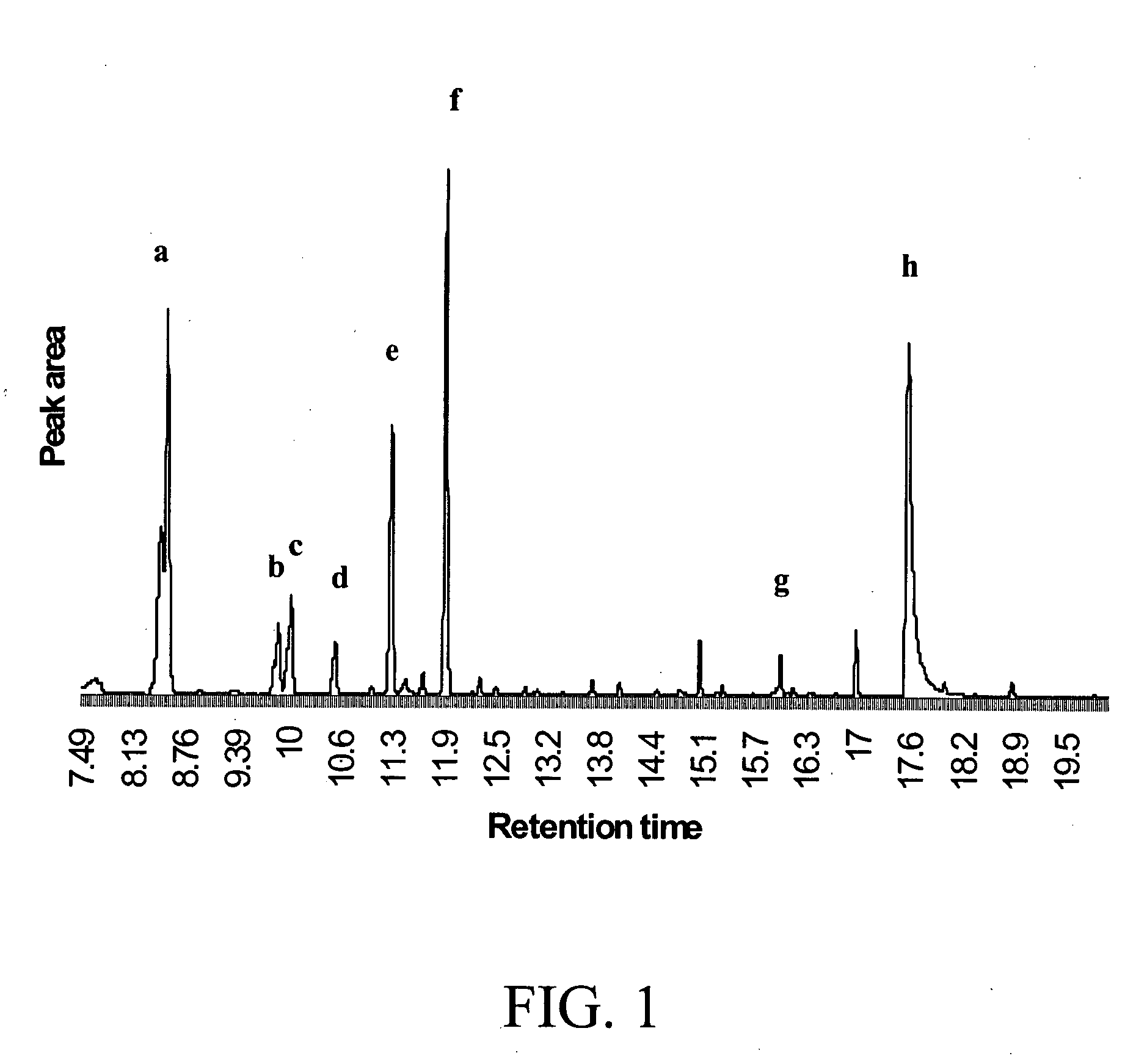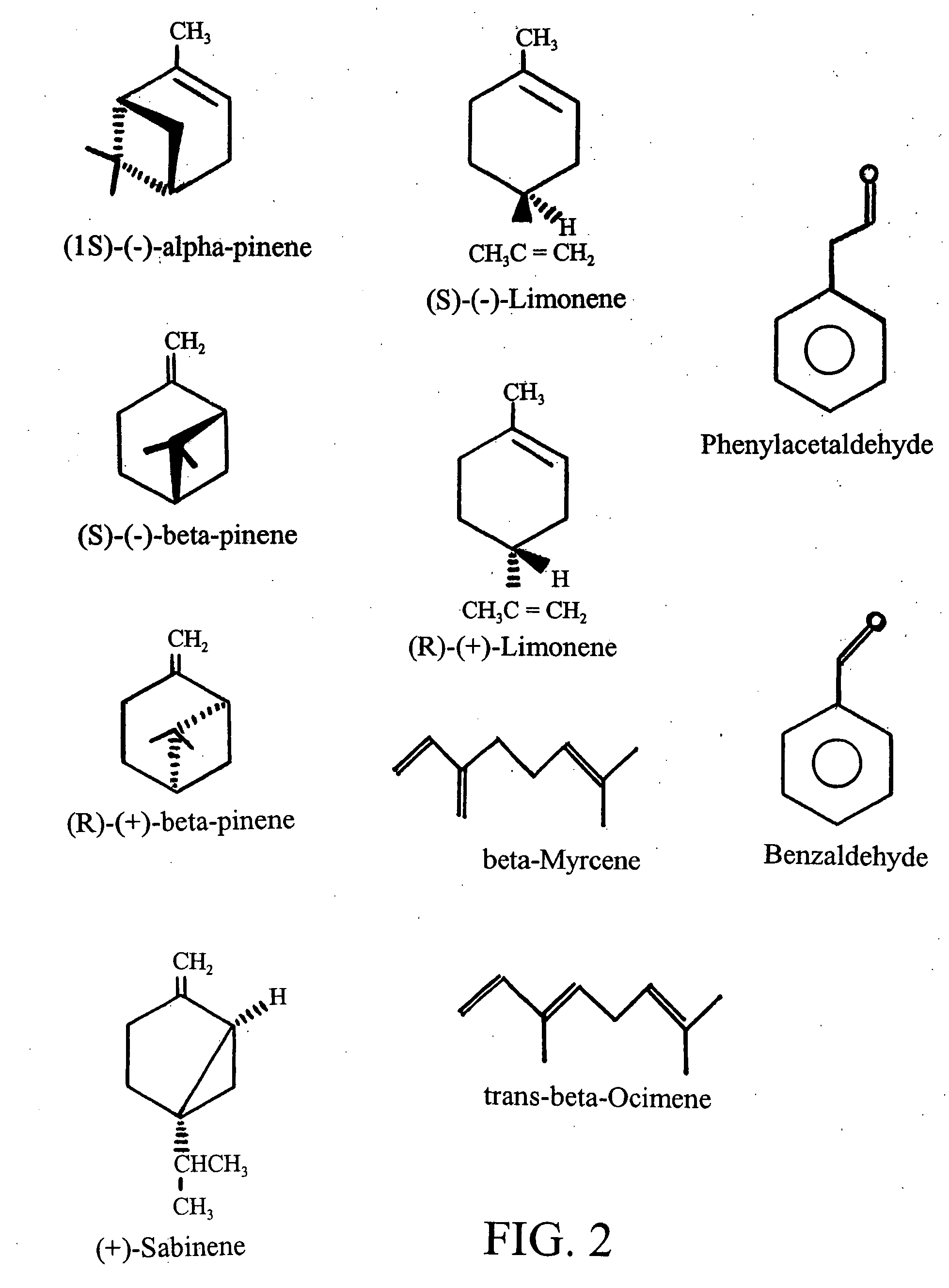Attractants for moths
- Summary
- Abstract
- Description
- Claims
- Application Information
AI Technical Summary
Benefits of technology
Problems solved by technology
Method used
Image
Examples
example 1
[0054] The following example describes our work on the characterization of the floral odor of Oregongrapee (Berberis aquifolium) as possible feeding attractants for moths. We collected and identified moths at flowers of Oregongrapee plants, and characterized the volatile chemicals emitted by those flowers.
[0055] Methods. Insect visitors to flowers of Oregongrapee plants were sampled using large white mesh cone shaped traps (Heliothis traps) placed directly above clusters of open flowers. Insects are trapped when they fly up from flowers into the cone of the trap and cannot escape the upper chamber. Traps were placed over flower clusters in late afternoon (1500 to 1600 hrs P.S.T.) and were checked the following morning (800 to 900 hrs P.S.T.) for insects. We sampled 37 times during April and May 2001: at the Yakima Agricultural Research Laboratory near Wapato (n=3), Randall Park in the city of Yakima (n=5), a residence in Yakima (n=4), Oak Creek Wildlife Preserve (n=9), Mud Lake (n=...
example 2
[0066] The following example describes the evaluation of six floral compounds, β-myrcene, α-pinene, β-pinene, limonene, methyl salicylate, and methyl-2-methoxybenzoate, alone and in various combinations, as attractants for alfalfa looper moths and cabbage looper moths.
[0067] Materials and Methods. A multi-colored version of the Universal Moth Trap, or UniTrap® (AgriSense, sold by Great Lakes IPM, Vestaburg, Mich.), was used in all experiments. The trap is an opaque white bucket beneath a yellow cone and a green lid. A 2.5×2.5 cm piece of Vaportape® (Hercon Environmental, Emigsville, Pa.) was placed in each trap bucket as a killing agent. Traps were hung from stakes at a height of about one meter in uncultivated areas adjacent to fields of alfalfa or directly within alfalfa fields. Traps were placed 12 meters apart in a north to south orientation, because of prevailing westerly winds.
[0068] For all experiments, a randomized complete block design was used, and treatments were random...
example 3
[0110] The following example describes the evaluation of six floral compounds, β-myrcene, alpha-pinene, beta-pinene, limonene, methyl salicylate, and methyl-2-methoxybenzoate, alone and in various combinations, as attractants for corn earworm moths.
[0111] Materials and Methods. The Universal Moth Trap (Great Lakes IPM, Vestaburg, Mich.) was used in all tests, with a 6 cm2 piece of Vaportape® (Hercon Environmental Inc., Emigsville, Pa.) in each trap bucket to kill captured moths. The trap is an opaque white bucket with a yellow cone and green lid. Traps were hung from stakes in the weedy borders around irrigated fields in the vicinity of sweet corn and alfalfa, near Mattawa, Grant County, Wash. Traps were placed 12 meters apart in a north to south orientation, because of prevailing westerly winds.
[0112] A randomized complete block design was used, and treatments (trap lures) were randomized each time that traps were checked. Traps were checked twice per week, and insects were place...
PUM
 Login to View More
Login to View More Abstract
Description
Claims
Application Information
 Login to View More
Login to View More - R&D
- Intellectual Property
- Life Sciences
- Materials
- Tech Scout
- Unparalleled Data Quality
- Higher Quality Content
- 60% Fewer Hallucinations
Browse by: Latest US Patents, China's latest patents, Technical Efficacy Thesaurus, Application Domain, Technology Topic, Popular Technical Reports.
© 2025 PatSnap. All rights reserved.Legal|Privacy policy|Modern Slavery Act Transparency Statement|Sitemap|About US| Contact US: help@patsnap.com


